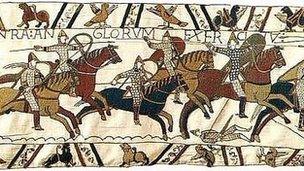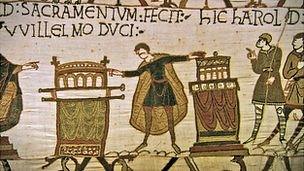Alderney Library plans own tapestry panel
- Published

More than 600 people, 200 horses and 50 Latin inscriptions were included in the Bayeux Tapestry
Alderney Library plans to create its own version of the missing final segment of the Bayeux Tapestry.
The famous tapestry tells the story of the conquest of Britain by William the Conqueror and is about 20in (50cm) high and 230ft (70m) long.
However, the final segment was lost and library staff hope to stitch their own Channel Islands version.
Librarian Kate Russell said she wanted to involve as many people as possible in the project.
She said: "I'm hoping volunteers will be on hand so that absolutely anyone can come anytime to help."
Ms Russell said: "When the tapestry was found in Bayeux Cathedral there was already a frayed end with an obviously missing conclusion.
"Since then someone has created a potential candidate for what that conclusion could have been and that was Jan Messent.
"She gave us permission to borrow from her finale so some of the images we will be stitching have been created by her."
Ms Messent, an author and former embroidery lecturer, produced an 8ft (2.4m) final section after researching the methods used in constructing the Bayeux Tapestry.
The rest of the design has been put together by Alderney artist Pauline Black.

The tapestry shows Harold swearing an oath to William before betraying him by taking the throne
Ms Russell said: "It will be about 10ft (3m) long - most of the experts say that the missing piece would have been about that long and would have ended with William's coronation.
"We've tacked on a little bit extra to show the construction of the Tower of London, which had already begun at the time of his coronation."
As to a completion date, she said it would depend on how many people got involved in the project.
The Bayeux Tapestry was commissioned by William the Conqueror's half-brother Bishop Odo to celebrate his victory over Harold Godwinson at the Battle of Hastings in 1066.
It was unveiled in 1077 at the dedication of the Bayeux Cathedral and shows events from a Norman point of view from the death of King Edward the Confessor to the Norman victory over the English, with the missing section probably showing his coronation.
The Channel Islands were part of the Dukedom of Normandy when William invaded England in 1066 and won the crown.